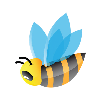




July 15th. Nick and I went to tidy up the newly united hive and take the surplus brood box off the top. Bees were squeezing through a warped joint in the top brood box, using it as an entrance as well as using the main entrance. A surprise awaited us in the top box. There were young larvae and royal jelly sealed into queen cells, where should be none. I fail to understand why they are trying to make new queens in a hive that already has one. Are they trying to make queens out of drone larvae? Isn’t there a laying queen in the colony already? We didn’t know that to do about it. Have we accidentally introduced a young queen into a hive which already has a queen down below?
After shaking all the bees down into the hive, we removed that top brood box as planned. We’ll go back in a few days and see what actions the bees have taken and take our lead from the bees. Will there be more queen cells above the queen excluder I really hope not.
Just when it seems plain sailing something often happens to confound you. That’s the pleasure and the pain of beekeeping.
July 23rd. I gave varroa treatment to both colonies.
When I opened hive two I found there weren’t any queen cells above the queen excluder. There is quite a bit of honey in the hive, but not as many bees as I expected. I inspected the brood properly and discovered there was no sealed brood, but an area of unsealed brood, all drones, and a few empty queen cups. My guess is that they’ve swarmed and have a new queen just beginning to lay. I didn’t see her. Just in case they are queenless I took a frame with day old larvae from the other hive so they can convert one of them into an emergency queen should they need to. They do this by feeding up very young larvae with royal jelly and extending the cell into a queen cup so there is room for a bigger bee to develop. If they already have a young queen they will simply adopt the new brood and it will boost their numbers.
I will go back and find out if they are making a new queen in a few days’ time. If they are not making a queen I’ll assume all is well.
Val Hicken

June When we returned from holiday is was too hot and sultry so I left it a few days before checking the hives. On inspection today we found honey and contented healthy looking bees in hive two. They have a super almost full of honey, mostly capped (sealed in with wax.) When I scrapped the wax the honey oozed out so we don’t need to extract it immediately. Instead we just put an extra super on for them to fill. Hive three is still a smallish colony, but they are making headway storing honey. We didn’t look into the brood of either hive except to sprinkle some varroa drops in.
Hive one, which we always leave till last in case they are bad tempered, have swarmed right out. I am quite relieved really as we won’t have to mess around with difficult bees anymore. There are still about four frames of bees left and no worker brood. There is some patchy drone brood, some of which is very young. I looked for signs of a laying worker. A laying worker will usually lay haphazardly with several eggs to a cell. We didn’t spot a virgin queen. We decided to unite them with hive three. If you lay a sheet of newspaper on top of the resident bees and put the new bees above that, the new arrivals will chew through the paper. It prevents fighting as it gives time for the new bees’ scent to dissipate. They settle down to live together harmoniously. Foraging bees will return to their original hive, so that’s a bit of a nuisance.
July 4th. I took 10 year old Rufin with me round to the bees to help. It was his first visit because I had deemed it too dangerous to take a child with me while the bolshy bees were there. Now they have swarmed out things are very peaceful at the hives again. Rufin was as good as could be and operated the smoker. I opened hive two purely because I knew what we would find in there, and I could use it to demonstrate the intricacies of life in the hive to him. He was riveted and of course he loved herding the bees around with smoke.
I only wanted to shake the bees who had returned to their original site back into hive three again. Rufin displayed nerves of steel when we had several hundred bees flying around us. He also survived the giant bee suit, rubber gloves and fur lined wellies that he had to wear in a very muggy twenty-six degrees centigrade.



| District council Newsletter |
| Village Agent |
| Bath Road |
| Local Plan |
| Nbhd Development plan(NDP) |
| Eastington Primary School |
| St Michaels Anglican Church |
| Eastington Methodist Church |
| Citizens Advice Bureau |
| EARS (Road Safety) |
| ecn magazine |
| E.C.Orchard Group. |
| Slimming World |
| Jolly Joggers |
| PAWS |
| PROWD (footpaths) |
| Madge of Millend |
| Bee Keepers Diary |
| PAWS (wetland survey) |
| Autumn Flower Show |
| Advertisements |
| Puzzle Page |